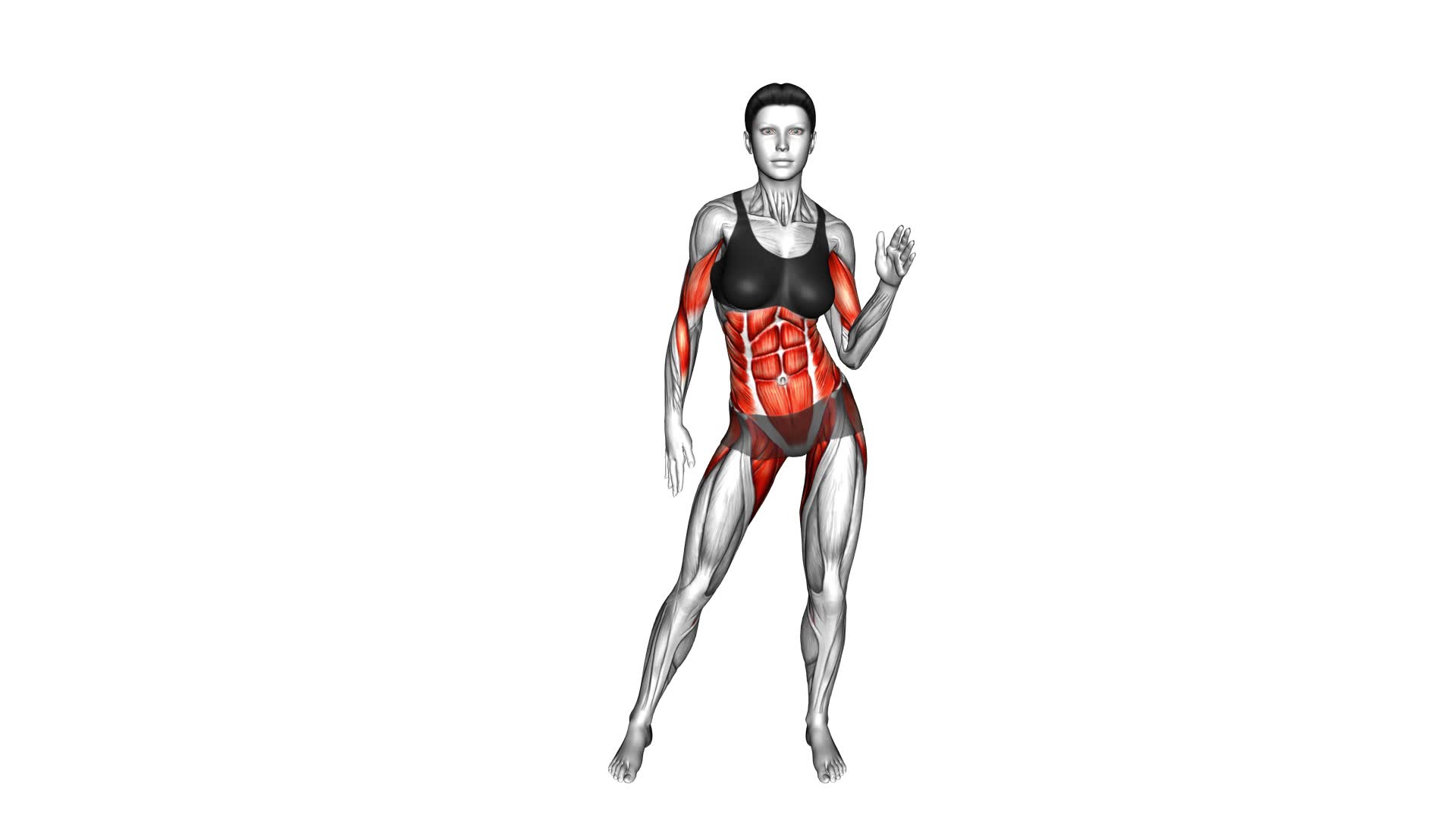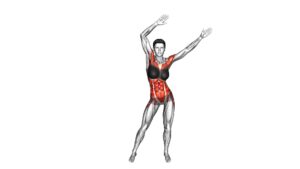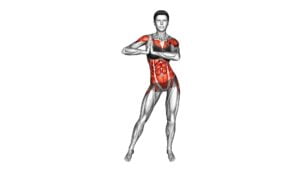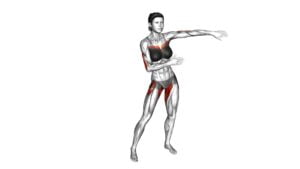Standing Hip Frontal Rotation Curl (female) – Video Exercise Guide & Tips

Are you looking to strengthen and tone your hips? Look no further than the Standing Hip Frontal Rotation Curl.
Watch This Exercise Video
This exercise targets the muscles in your hips and can be done by women of all fitness levels.
In this video exercise guide, you'll find step-by-step instructions on how to properly perform the exercise, along with helpful tips to maximize its effectiveness.
So grab your mat and get ready to sculpt those hips!
Key Takeaways
- The Standing Hip Frontal Rotation Curl is beneficial for increasing hip strength, stability, and mobility.
- It targets the hip rotator muscles and enhances rotational movement of the hips.
- It is particularly beneficial for athletes and individuals involved in lateral movements.
- Proper equipment selection and form are important for safety, effectiveness, and maximizing the benefits of the exercise.
Benefits of the Standing Hip Frontal Rotation Curl
You'll experience increased hip strength and stability with the Standing Hip Frontal Rotation Curl. This exercise targets the hip muscles, specifically the hip rotators, which play a crucial role in hip mobility. By performing the Standing Hip Frontal Rotation Curl, you can improve the rotational movement of your hips, allowing for better overall mobility and flexibility.
During the exercise, you'll stand with your feet shoulder-width apart and your hands resting on your hips. From this position, you'll rotate one hip outward while maintaining a stable core and proper posture. This movement engages the hip rotator muscles, building strength and stability in the hips.
The Standing Hip Frontal Rotation Curl is particularly beneficial for athletes and individuals involved in activities that require lateral movements, such as sports like tennis or soccer. By strengthening the hip rotators, you can enhance your performance in these activities and reduce the risk of hip injuries.
As you improve your hip strength and stability through the Standing Hip Frontal Rotation Curl, you'll also notice increased balance and proprioception. These improvements can have a positive impact on your overall athletic performance and everyday activities.
Now that you understand the benefits of the Standing Hip Frontal Rotation Curl, let's move on to discussing the equipment needed for this exercise.
Equipment Needed for the Exercise
Now let's talk about the equipment you'll need for the Standing Hip Frontal Rotation Curl.
The main piece of equipment required for this exercise is a cable machine with a low pulley attachment. This will allow you to perform the movement effectively and target the desired muscles.
If you don't have access to a cable machine, you can use resistance bands as an alternative. It's important to use the proper equipment to ensure you can perform the exercise correctly and safely.
Required Exercise Equipment
To perform the Standing Hip Frontal Rotation Curl exercise, you'll need exercise equipment. Here are four equipment options you can consider:
- Resistance band: This elastic band provides resistance and can be wrapped around your thighs to add intensity to the exercise.
- Dumbbells: Holding dumbbells in your hands can help increase the challenge and strengthen your hip muscles.
- Cable machine: Using a cable machine with ankle attachments allows for smooth and controlled movements while targeting the hip muscles.
- Stability ball: Placing a stability ball between your knees can help engage your core and add stability to the exercise.
When using exercise equipment, it's important to keep some safety precautions in mind. Make sure to choose the appropriate weight or resistance level that suits your fitness level. Maintain proper form and technique throughout the exercise to avoid any strain or injury.
Start with lighter weights or resistance and gradually increase as you progress. Always consult with a fitness professional if you have any concerns or questions about using exercise equipment properly and safely.
Alternatives to Equipment
Consider using household items as alternatives to exercise equipment for the Standing Hip Frontal Rotation Curl exercise. If you don't have access to resistance bands, you can use items like towels or belts to create resistance. Simply wrap the towel or belt around your thigh and hold the ends in your hands while performing the exercise. This will provide a similar level of resistance as a band.
Additionally, if you don't have any equipment at all, you can still perform bodyweight exercises to target the same muscles. Bodyweight exercises such as side leg lifts or standing hip abductions can help strengthen your hip muscles without the need for any equipment.
Importance of Proper Equipment?
If you don't have access to resistance bands, you can still effectively perform the Standing Hip Frontal Rotation Curl exercise with the proper equipment. Using the right equipment not only allows you to perform the exercise correctly, but it also ensures your safety and maximizes the benefits of the exercise. Here are some key reasons why proper equipment is important:
- Safety: Using the right equipment reduces the risk of injury during the exercise. It provides stability and support to your body, allowing you to maintain proper form and technique.
- Targeted muscle engagement: The proper equipment helps to isolate and activate the specific muscles targeted by the exercise. This ensures that you're effectively working the intended muscle group and getting the most out of your workout.
- Progression: With the right equipment, you can gradually increase the resistance or difficulty level of the exercise as your strength and fitness level improves. This allows for progressive overload, leading to continued muscle growth and development.
- Comfort and convenience: Using the proper equipment makes the exercise more comfortable and convenient to perform. It ensures that you have the necessary tools and accessories to properly execute the movement, enhancing your overall exercise experience.
Proper Form and Technique for the Exercise
You need to maintain proper form and technique for the Standing Hip Frontal Rotation Curl (female) exercise. To ensure you get the most out of this exercise and avoid common mistakes, here are some tips to follow.
First, it's important to avoid using momentum to swing your leg up. Instead, focus on engaging your hip muscles and controlling the movement throughout. This will help you target the correct muscles and prevent strain or injury.
Additionally, be mindful of keeping your core engaged and maintaining good posture. Avoid arching your back or hunching your shoulders. By keeping your spine neutral and shoulders relaxed, you can maximize the effectiveness of the exercise and reduce the risk of any discomfort.
Another common mistake is lifting your leg too high or rotating it too far. The key is to perform the movement within a comfortable range of motion. You should feel a contraction in your hip muscles without any pain or strain.
To maximize the effectiveness of the Standing Hip Frontal Rotation Curl, focus on performing the exercise slowly and with control. This will help you engage the targeted muscles more effectively and improve your overall strength and stability.
Modifications for Beginners or Those With Limitations
If you're a beginner or have limitations, there are modifications you can make to the Standing Hip Frontal Rotation Curl exercise. First, focus on performing gentle range of motion movements to avoid strain or injury.
You can also simplify the exercise by using lighter weights or resistance bands, or even just your body weight.
Gentle Range of Motion
To modify the Standing Hip Frontal Rotation Curl for beginners or individuals with limitations, prioritize a gradual and controlled range of motion. This will help ensure joint health and prevent injuries. Here are some ideas to consider when modifying the exercise:
- Start with a smaller range of motion and gradually increase as you feel more comfortable and confident.
- Focus on maintaining proper form throughout the movement, keeping your core engaged and your back straight.
- Use lighter weights or resistance bands to reduce the strain on your joints and muscles.
- Incorporate stretching exercises before and after the workout to improve flexibility and reduce the risk of injury.
Simplified Exercise Variations
For beginners or individuals with limitations, modify the Standing Hip Frontal Rotation Curl by gradually increasing the range of motion while maintaining proper form and using lighter weights or resistance bands to reduce strain on joints and muscles.
To simplify this exercise, you can start by performing it without any weights or resistance bands. This will allow you to focus on the movement and build strength before adding additional resistance.
Another simplified variation is to perform the exercise while seated on a stability ball or chair, which provides added support and stability.
Additionally, you can perform the exercise with a smaller range of motion, only rotating the hips to a comfortable extent. Remember to listen to your body and adjust the exercise as needed to accommodate any limitations you may have.
Now, let's explore equipment-free modifications for this exercise.
Equipment-Free Modifications
To modify the Standing Hip Frontal Rotation Curl for beginners or individuals with limitations, try performing the exercise without any equipment. Here are some equipment-free modifications and variations for beginners:
- Bodyweight only: Instead of using resistance bands or weights, focus on the movement and engage your core muscles to perform the exercise using just your bodyweight.
- Decrease range of motion: If you find it challenging to rotate your hip fully, you can reduce the range of motion by rotating your hip to a comfortable extent.
- Use a chair for support: If balance is an issue, you can perform the exercise while holding onto a chair for support. This will help stabilize your body and allow you to focus on the movement.
- Slow down the tempo: Instead of performing the exercise at a fast pace, slow down the tempo to maintain control and focus on proper form.
Common Mistakes to Avoid While Performing the Exercise
You often make these common mistakes while performing the Standing Hip Frontal Rotation Curl. One common mistake is using momentum to swing your leg instead of engaging your hip muscles. This can reduce the effectiveness of the exercise and increase the risk of injury.
To improve, focus on controlling the movement and using your hip muscles to lift and lower your leg. Another mistake is allowing your torso to twist or lean to one side during the exercise. This can strain your lower back and compromise your form.
To avoid this, keep your core engaged and maintain a stable torso throughout the movement. Additionally, many people neglect to fully extend their leg at the bottom of the movement, which limits the range of motion and reduces the effectiveness of the exercise.
To correct this, make sure to fully extend your leg before beginning the next repetition. By avoiding these common mistakes and following these tips for improvement, you can optimize the benefits of the Standing Hip Frontal Rotation Curl.
Tips for Maximizing the Effectiveness of the Exercise
How can you enhance the effectiveness of the Standing Hip Frontal Rotation Curl? To maximize results and muscle activation during this exercise, consider the following tips:
- Engage your core: Before starting the movement, activate your core muscles by pulling your belly button towards your spine. This will help stabilize your body and prevent any unnecessary movement.
- Maintain proper form: Throughout the exercise, ensure that your back remains straight and your shoulders are pulled back. Avoid rounding your back or hunching your shoulders, as this can lead to poor posture and decreased effectiveness.
- Focus on the hip muscles: While performing the movement, concentrate on contracting the hip muscles to generate the rotational motion. Visualize the muscles working and squeeze them at the top of the movement for maximum activation.
- Control the speed: Avoid rushing through the exercise. Instead, focus on performing each repetition slowly and with control. This will increase the time under tension for the hip muscles, resulting in greater muscle activation and improved results.
Frequently Asked Questions
How Many Sets and Repetitions Should I Do for the Standing Hip Frontal Rotation Curl?
For the standing hip frontal rotation curl, it's important to focus on form and gradually increase intensity. Start with 2-3 sets of 10-12 repetitions to build strength and stability.
As a beginner, you can modify the exercise by using lighter weights or no weights at all. To avoid common mistakes, engage your core, keep your back straight, and move in a controlled manner.
Remember to consult with a fitness professional for personalized guidance.
Can I Perform the Standing Hip Frontal Rotation Curl With Ankle Weights for Added Resistance?
Yes, you can definitely perform the standing hip frontal rotation curl with ankle weights for added resistance. Using ankle weights can provide several benefits, such as increasing the intensity of the exercise and targeting the muscles in your hips and thighs even more effectively.
However, if you don't have ankle weights or prefer alternatives, you can still work on strengthening those muscles by doing exercises like lateral leg raises or clamshells.
Is It Normal to Feel a Burning Sensation in the Hip Muscles While Performing This Exercise?
Yes, it's normal to feel a burning sensation in your hip muscles while doing this exercise. This is because the standing hip frontal rotation curl targets and engages the muscles in your hips, which can lead to a feeling of burning or fatigue.
It's important to listen to your body and not push yourself too hard, but a mild burning sensation is generally a sign that you're working the muscles effectively.
Can the Standing Hip Frontal Rotation Curl Help Improve My Balance and Stability?
Yes, the standing hip frontal rotation curl can help improve your balance and increase stability.
By engaging the hip muscles and working on rotational movements, this exercise targets the core and lower body, which are essential for balance.
It challenges your muscles to stabilize and control the movement, ultimately enhancing your balance and stability.
Incorporating this exercise into your routine can lead to improved overall body control and coordination.
Are There Any Specific Warm-Up Exercises That I Should Do Before Attempting the Standing Hip Frontal Rotation Curl?
Before attempting the standing hip frontal rotation curl, it's important to start with a proper pre-workout warm-up routine. Incorporate exercises that focus on mobilizing your hips and activating your core muscles. This will help prepare your body for the movement and reduce the risk of injury.
Some common mistakes to avoid during this exercise include using momentum instead of controlled movements and not engaging your core properly. Take your time and focus on form to get the most out of this exercise.
Conclusion
The standing hip frontal rotation curl is a beneficial exercise that targets the hip muscles. It can be performed with minimal equipment and proper form is crucial for effectiveness.
Beginners or individuals with limitations can make modifications to suit their needs. It's important to avoid common mistakes while performing the exercise to prevent injury.
By following these tips, you can maximize the effectiveness of the exercise and achieve your fitness goals.

Author
Years ago, the spark of my life’s passion ignited in my mind the moment I stepped into the local gym for the first time. The inaugural bead of perspiration, the initial endeavor, the very first surge of endorphins, and a sense of pride that washed over me post-workout marked the beginning of my deep-seated interest in strength sports, fitness, and sports nutrition. This very curiosity blossomed rapidly into a profound fascination, propelling me to earn a Master’s degree in Physical Education from the Academy of Physical Education in Krakow, followed by a Sports Manager diploma from the Jagiellonian University. My journey of growth led me to gain more specialized qualifications, such as being a certified personal trainer with a focus on sports dietetics, a lifeguard, and an instructor for wellness and corrective gymnastics. Theoretical knowledge paired seamlessly with practical experience, reinforcing my belief that the transformation of individuals under my guidance was also a reflection of my personal growth. This belief holds true even today. Each day, I strive to push the boundaries and explore new realms. These realms gently elevate me to greater heights. The unique combination of passion for my field and the continuous quest for growth fuels my drive to break new ground.







